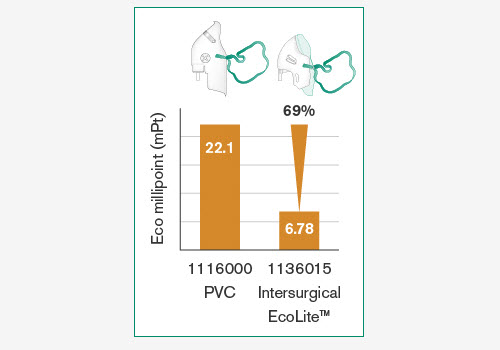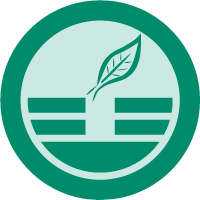The Intersurgical EcoLite™ range of oxygen and aerosol therapy products is an important part of the Eco range designed as part of our ongoing focus on sustainable development.
Improved patient comfort has been key to the ongoing development of the range. The latest manufacturing technology has enabled us to combine two non-PVC materials in the same product, the polypropylene material forming the body of the Intersurgical EcoLite™ mask is clear, lightweight and rigid enough to maintain the mask’s shape, whilst the second softer TPE material is utilised in the seal, which is in contact with the patient’s face.
The use of these materials and the unique design of the masks have resulted in a range of oxygen and aerosol therapy products which provide improved patient comfort and a reduced environmental impact. 1, 2, 3, 4, 5
All of the Intersurgical EcoLite™ face masks share the following key features and benefits:
• Soft chin, nose and side seals ensure exceptional levels of patient comfort.
• Lighter than PVC masks, more comfortable for the patient.
• Incurved nose seal eliminates the need for a separate nose clip, designed to prevent oxygen and aerosolised drugs entering the patient’s eyes.
• MRI compatible.
• Lower environmental impact.
More products, more choice
Wherever you see the distinctive green Eco logo you can be assured that we have worked hard to lower the environmental impact of these products.
Our current range of Intersurgical EcoLite™ products in the oxygen and aerosol range now includes:
• Intersurgical EcoLite™ aerosol masks
• Intersurgical EcoLite™ high concentration oxygen masks
• Intersurgical EcoLite™ oxygen masks
• Cirrus™2 nebuliser Intersurgical EcoLite™ mask kits
• Sentri™ ETCO2 medium concentration masks
• Intersurgical EcoLite™ tracheostomy masks
We have a video which highlights how changing from PVC masks to Intersurgical EcoLite™ masks has the potential to help healthcare providers reduce the amount of clinical waste they generate.
Comparing the environmental impact of products
We have used SimaPro 8 Life Cycle Assessment (LCA) software to assess the environmental aspects of our products following the ISO standards 14040:2006 and 14044:2006. By analysing the materials, packaging, energy used in manufacturing and disposal methods, this software enables us to quantify the environmental impact of our products, giving us a number in units of Eco millipoints.
The following examples illustrate the reduction of environmental impact between a traditional PVC oxygen mask and the Intersurgical EcoLite™ oxygen mask.
We have produced a video which highlights how changing from PVC masks to Intersurgical EcoLite™ masks has the potential to help healthcare providers reduce the amount of clinical waste they generate.

Products with lower Eco millipoints are more environmentally friendly, the Intersurgical EcoLite™ shows a 69% reduction in environmental impact.6
| Code | Description | Eco millipoint score |
| 1136015 | Intersurgical EcoLite™, adult, medium concentration oxygen mask - non PVC | 6.78 |
| 1116000 | Adult, medium concentration oxygen mask with nose clip - PVC | 22.1 |




To find out more about the Intersurgical EcoLite™ range or just have a question please get in touch.

























